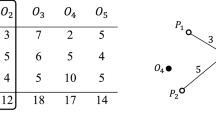Abstract
For nearest neighbor search, a user queries a server for nearby points of interest (POIs) with his/her location information. Our aim is to protect the user’s sensitive information against adversaries including the location-based service itself. Most research efforts have elaborated on reasonable trade-offs between privacy and utility. We propose a framework based on range search query without a trusted middleware. We design a query processing algorithm for the minimum set of candidate POIs by computing the local Voronoi diagram relevant to the cloaked region. Contrary to common belief that cloaking approaches using range search incur expensive processing and communication cost, the experimental results show that the framework incurs reasonable processing and communication overhead even for large cloaked regions.
Preview
Unable to display preview. Download preview PDF.
Similar content being viewed by others
References
Google latitude (2009)
Aggarwal, A., Hansen, M., Leighton, T.: Solving query-retrieval problems by compacting voronoi diagrams. In: STOC 1990: Proceedings of the twenty-second annual ACM symposium on Theory of computing, pp. 331–340. ACM, New York (1990)
Chow, C.-Y., Mokbel, M.: Enabling private continuous queries for revealed user locations, pp. 258–275 (2007)
de Berg, M., Cheong, O., van Kreveld, M., Overmars, M.: Computational Geometry: Algorithms and Applications, 3rd edn. Springer, Berlin
Duckham, M., Kulik, L.: A formal model of obfuscation and negotiation for location privacy. In: Gellersen, H.-W., Want, R., Schmidt, A. (eds.) PERVASIVE 2005. LNCS, vol. 3468, pp. 152–170. Springer, Heidelberg (2005)
Frikken, K.B., Atallah, M.J.: Privacy preserving route planning. In: WPES 2004: Proceedings of the 2004 ACM workshop on Privacy in the electronic society, pp. 8–15. ACM, New York (2004)
Gedik, B., Liu, L.: Protecting location privacy with personalized k-anonymity: Architecture and algorithms. IEEE Transactions on Mobile Computing 7(1), 1–18 (2008)
Ghinita, G.: Understanding the privacy-efficiency trade-off in location based queries. In: SPRINGL 2008: Proceedings of the SIGSPATIAL ACM GIS 2008 International Workshop on Security and Privacy in GIS and LBS, pp. 1–5. ACM, New York (2008)
Ghinita, G., Kalnis, P., Khoshgozaran, A., Shahabi, C., Tan, K.-L.: Private queries in location based services: anonymizers are not necessary. In: SIGMOD 2008: Proceedings of the 2008 ACM SIGMOD international conference on Management of data, pp. 121–132. ACM, New York (2008)
Gruteser, M., Grunwald, D.: Anonymous usage of location-based services through spatial and temporal cloaking. In: MobiSys 2003: Proceedings of the 1st international conference on Mobile systems, applications and services, pp. 31–42. ACM, New York (2003)
Hong, J.I., Landay, J.A.: An architecture for privacy-sensitive ubiquitous computing. In: MobiSys 2004: Proceedings of the 2nd international conference on Mobile systems, applications, and services, pp. 177–189. ACM, New York (2004)
Kalnis, P., Ghinita, G., Mouratidis, K., Papadias, D.: Preventing location-based identity inference in anonymous spatial queries. IEEE Transactions on Knowledge and Data Engineering 19(12), 1719–1733 (2007)
Khoshgozaran, A., Shahabi, C.: Blind evaluation of nearest neighbor queries using space transformation to preserve location privacy. In: Papadias, D., Zhang, D., Kollios, G. (eds.) SSTD 2007. LNCS, vol. 4605, pp. 239–257. Springer, Heidelberg (2007)
Kido, H., Yanagisawa, Y., Satoh, T.: An anonymous communication technique using dummies for location-based services. In: Proceedings. International Conference on Pervasive Services, ICPS 2005, July 2005, pp. 88–97 (2005)
Lee, D.: Furthest neighbour voronoi diagrams and applications. Technical Report Report 80-11-FC-04, Dept. Elect. Engrg. Comput. Sci., Northwestern Univ., Evanston, IL (1980)
Maria Damiani, C.S.: Elisa Bertino. Probe: an obfuscation system for the protection of sensitive location information in lbs. Technical report
Megiddo, N.: Linear-time algorithms for linear programming in r3 and related problems. In: 23rd Annual Symposium on Foundations of Computer Science, 1982. SFCS 2008, November 1982, pp. 329–338 (1982)
Mokbel, M.F., Chow, C.-Y., Aref, W.G.: The new casper: query processing for location services without compromising privacy. In: Proceedings of the 32nd international conference on Very large data bases, pp. 763–774. ACM, New York (2006)
Nergiz, M.E., Atzori, M., Saygin, Y.: Towards trajectory anonymization: a generalization-based approach. In: SPRINGL 2008: Proceedings of the SIGSPATIAL ACM GIS 2008 International Workshop on Security and Privacy in GIS and LBS, pp. 52–61. ACM, New York (2008)
Okabe, A., Boots, B., Sugihara, K., Chi, S.N.: Spatial Tessellations: Concepts and Applications of Voronoi Diagrams, 2nd edn. Wiley, Chichester (2000)
Preparata, F.P.: Minimum spanning circle. Technical report, Univ. Illinois, Urbana, IL, in: Steps into Computational Geometry (1977)
Reed, J., Krizman, K., Woerner, B., Rappaport, T.: An overview of the challenges and progress in meeting the e-911 requirement for location service. IEEE Communications Magazine 36(4), 30–37 (1998)
Samarati, P., Sweeney, L.: Generalizing data to provide anonymity when disclosing information (abstract). In: PODS 1998: Proceedings of the seventeenth ACM SIGACT-SIGMOD-SIGART symposium on Principles of database systems, p. 188. ACM, New York (1998)
Shamos, M.I., Hoey, D.: Closest-point problems. In: SFCS 1975: Proceedings of the 16th Annual Symposium on Foundations of Computer Science (sfcs 1975), Washington, DC, USA, pp. 151–162. IEEE Computer Society, Los Alamitos (1975)
Sweeney, L.: k-anonymity: a model for protecting privacy. Int. J. Uncertain. Fuzziness Knowl.-Based Syst. 10(5), 557–570 (2002)
Theodoridis, Y.: The r-tree-portal (2009)
Toussaint, G.T.: A simple linear algorithm for intersecting convex polygons. The Visual Computer 1, 118–123 (1985)
Yiu, M.L., Jensen, C., Huang, X., Lu, H.: Spacetwist: Managing the trade-offs among location privacy, query performance, and query accuracy in mobile services. In: IEEE 24th International Conference on Data Engineering, ICDE 2008, April 2008, pp. 366–375 (2008)
Author information
Authors and Affiliations
Editor information
Editors and Affiliations
Rights and permissions
Copyright information
© 2010 Springer-Verlag Berlin Heidelberg
About this paper
Cite this paper
Kim, H. (2010). A Spatial Cloaking Framework Based on Range Search for Nearest Neighbor Search. In: Garcia-Alfaro, J., Navarro-Arribas, G., Cuppens-Boulahia, N., Roudier, Y. (eds) Data Privacy Management and Autonomous Spontaneous Security. DPM SETOP 2009 2009. Lecture Notes in Computer Science, vol 5939. Springer, Berlin, Heidelberg. https://doi.org/10.1007/978-3-642-11207-2_8
Download citation
DOI: https://doi.org/10.1007/978-3-642-11207-2_8
Publisher Name: Springer, Berlin, Heidelberg
Print ISBN: 978-3-642-11206-5
Online ISBN: 978-3-642-11207-2
eBook Packages: Computer ScienceComputer Science (R0)




